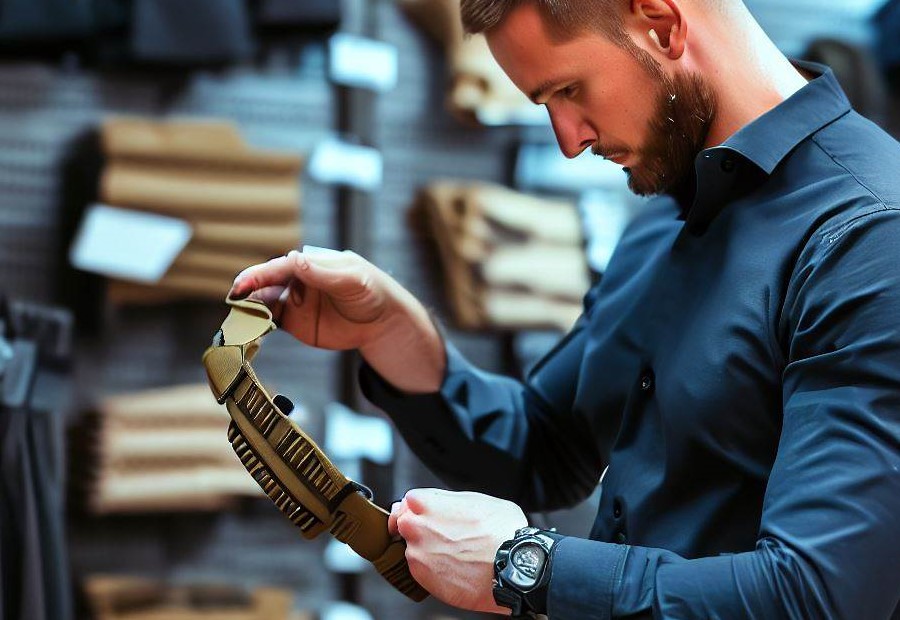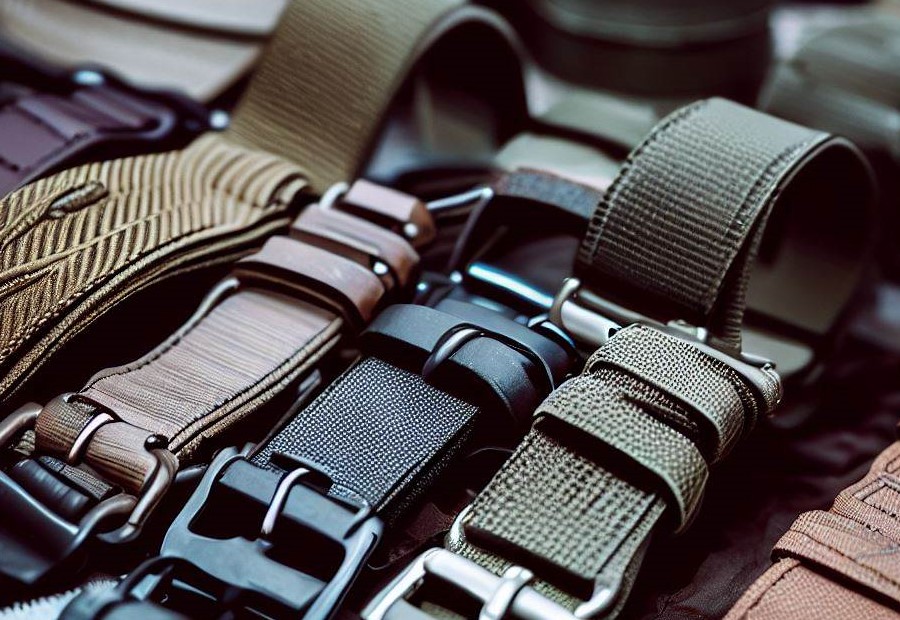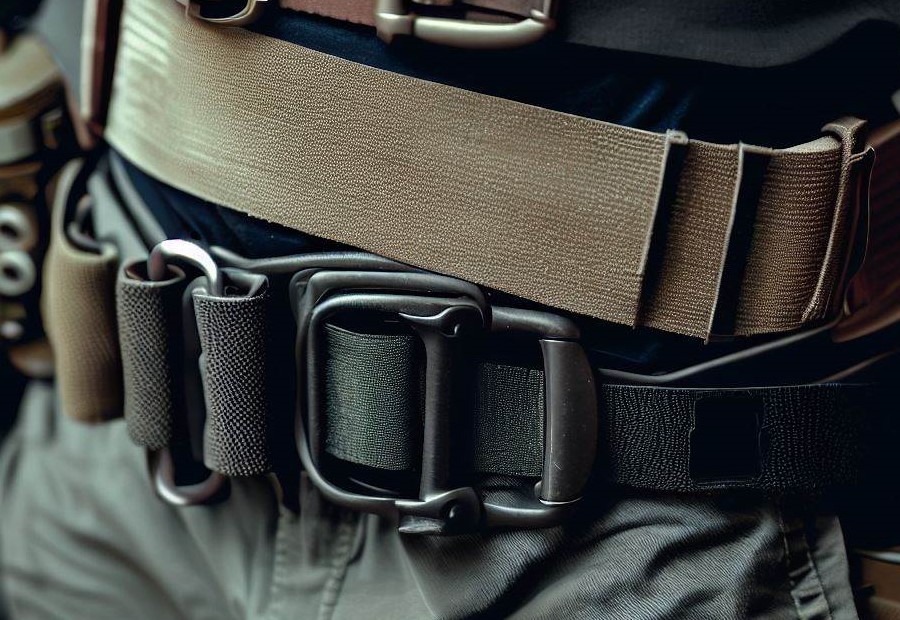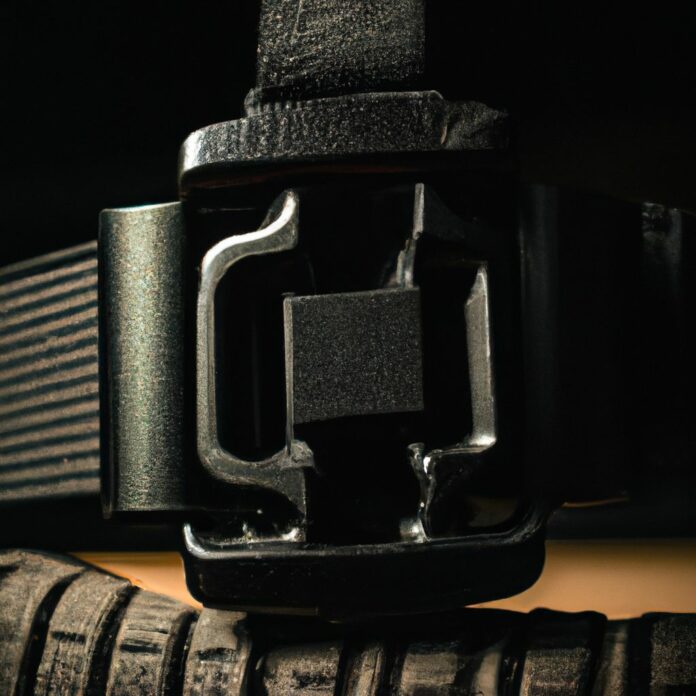Choosing the right tactical belt is crucial for those who rely on it for various activities such as law enforcement, military operations, outdoor adventures, or everyday carry. The tactical belt serves as a critical piece of gear to hold essential tools, equipment, and accessories securely and comfortably.
A well-chosen tactical belt can enhance performance, provide convenience, and ensure safety during challenging situations. Taking reputable sources and expert advice into account, this article will guide you through the process of selecting the perfect tactical belt.
Factors to Consider on How to Choose a Tactical Belt

When it comes to choosing a tactical belt, there are several important factors to consider. From the material and durability to the width and thickness, each aspect can greatly impact its performance and functionality.
The fastening mechanism, adjustability, and weight capacity are also crucial aspects to take into account. Additionally, the inclusion of belt accessories and compatibility with other gear can enhance its practicality. In this section, we’ll delve into these factors, providing insights to help you make an informed decision for your tactical needs.
Material and Durability
When selecting a tactical belt, one of the critical factors to take into account is the material and its durability. The provided table showcases the different materials commonly utilized for tactical belts along with their respective levels of durability:
| Material | Durability |
| Nylon | Durable and resistant to wear and tear. Suitable for everyday use. |
| Polymer | Highly durable, lightweight, and resistant to extreme weather conditions. |
| Leather | Offers excellent durability and a professional appearance. May require more care and maintenance. |
| Webbing | Strong, lightweight, and resistant to mildew and rot. |
Pro-tip: When evaluating the material and durability of a tactical belt, it is essential to consider the specific requirements of your intended use. If you need a belt that can endure rough outdoor environments or heavy-duty tasks, opt for materials like nylon or polymer. For a more formal or professional setting, leather belts provide both durability and a refined appearance.
Width and Thickness
When choosing a tactical belt, it is important to consider both the width and thickness. The width of the belt determines its stability and how well it distributes the weight of your gear. Opting for a wider belt, such as one that measures 1.75 inches, not only offers more support but also prevents sagging or rolling. Alternatively, a narrower belt may be more comfortable for everyday or concealed carry purposes.
The thickness of the belt also plays a significant role in its strength and durability. A thicker belt, typically constructed with multiple layers of reinforced material, can handle heavy loads and provide superior support. However, a thinner belt may be more lightweight and flexible, suiting casual use or individuals who prefer a less noticeable appearance.
| Width | Thickness |
|---|---|
| 1.75 inches | Thicker with multiple layers for increased durability |
| 1.5 inches | Medium thickness for a balance between strength and comfort |
| 1.25 inches | Thinner for lightweight and flexible use |
Ensuring that your tactical belt has the right width and thickness is vital in securely holding your equipment without compromising comfort. Take into account your specific needs and preferences when selecting the width and thickness of your tactical belt.
Fastening Mechanism
The fastening mechanism is a crucial factor to consider when selecting a tactical belt that suits your requirements. It plays a significant role in keeping the belt securely in place and facilitating easy wear and removal.
Below is a comprehensive table highlighting various types of fastening mechanisms commonly used in tactical belts:
| Fastening Mechanism | Description |
| Buckle | A traditional buckle system with a tongue and prong that fits into holes in the belt. It offers a secure fit and adjustable sizing. |
| Velcro | A hook and loop closure system that allows for quick and easy adjustment. It provides a secure hold but may wear out over time. |
| Cobra Buckle | A heavy-duty buckle that utilizes a latch mechanism for quick release. It is well-known for its strength and reliability. |
| Ratchet | A belt equipped with a ratcheting system allowing precise adjustment and a secure fit. It is user-friendly and enables quick release. |
| Quick Release | A mechanism enabling instant belt release with the push of a button or lever. It is particularly useful in emergency situations. |
When choosing a tactical belt, carefully consider the type of fastening mechanism that aligns with your needs and preferences. Evaluate its durability, ease of use, and security features. Additionally, ensure that the fastening mechanism is compatible with any additional accessories you intend to attach to your belt.
Pro-tip: Prior to purchasing a tactical belt, test the fastening mechanism to ensure it meets your specific requirements.
Adjustability
The adjustability of a tactical belt is a crucial aspect to take into account when selecting the appropriate belt. It allows you to personalize the fit and guarantees comfort while using it.
One vital factor of adjustability is the existence of multiple belt holes or a ratchet system, which permits effortless adjustment of the belt’s size. This guarantees a secure fit, whether you need to tighten or loosen the belt.
Another consideration is the length of the belt. Seek out belts that come in various sizes or ones that can be trimmed to match your waist size. This ensures that you can achieve the perfect fit, no matter your body shape or the layers of clothing you have on.
Moreover, certain tactical belts provide adjustable buckles or closure systems. This enables you to rapidly and easily release or secure the belt based on your requirements. Look for mechanisms that are durable and dependable, ensuring that the belt stays in place during demanding activities.
The adjustability of a tactical belt ensures that it can be comfortably worn with different gear or holsters. It allows for flexibility in carrying equipment and ensures that your belt does not impede your movements.
When selecting a tactical belt, make adjustability a priority to ensure an ideal fit and maximize comfort during various activities. Remember to consider factors such as belt holes, length options, and buckle mechanisms to find the perfect belt that matches your needs.
By taking adjustability into account, you can confidently select a belt that will fulfill your requirements and enhance your performance in diverse situations.
Weight Capacity
To ensure that a tactical belt can effectively support your gear and accessories, one crucial factor to consider is its weight capacity. It is important to assess your own needs and the weight of the gear you plan to carry. Different belts have varying weight capacities, and choosing the right one for your specific requirements is essential to prevent any potential issues or discomfort during use.
When evaluating the weight capacity of a tactical belt, it is necessary to look for specific details provided by the manufacturer. These details can usually be found in the product description or specifications. The weight capacity is typically expressed in pounds or kilograms, indicating the maximum amount of weight the belt can support without compromising its performance or durability.
For instance, a high-quality tactical belt might possess an impressive weight capacity of 500 pounds, ensuring that it can securely hold your holster, magazine pouches, and other necessary equipment. This level of weight capacity offers peace of mind, knowing that the belt will remain secure and reliable, even in demanding situations.
However, it is crucial to assess your own needs and the weight of the gear you plan to carry. If you have lighter gear, a tactical belt with a lower weight capacity may be sufficient. Conversely, if your gear is bulkier or heavier, opting for a belt with a higher weight capacity is recommended to ensure stability and comfort during use.
By carefully considering the weight capacity of a tactical belt, you can make an informed decision and select a belt that matches your specific requirements, providing the necessary support and functionality for your tactical activities.
Belt Accessories and Compatibility
The table below highlights the key aspects to consider for belt accessories and compatibility when choosing a tactical belt:
| Aspect | Details |
| Modularity | Tactical belts with MOLLE or PALS webbing allow for easy attachment of pouches, holsters, and other belt accessories. |
| Buckle Compatibility | Ensure that the tactical belt’s buckle is compatible with your preferred belt accessories and gear, such as belt loops or suspenders. |
| Attachment Points | Consider the number and positioning of attachment points on the belt to accommodate different belt accessories. More attachment points provide flexibility in carrying different equipment. |
| Size Adjustability | Choose a tactical belt that offers size adjustability to accommodate different waist sizes and provide a secure fit for belt accessories. |
| Durability | Ensure the belt accessories, such as pouches or holsters, are made from high-quality materials to withstand rigorous use and maintain functionality. |
Considering these factors ensures that your tactical belt not only meets your specific belt accessory and compatibility needs but also provides durability and flexibility for various tactical situations.
Types of Tactical Belts

When it comes to tactical belts, there’s a wide array of options to choose from. In this section, we’ll dive into the various types of tactical belts available, each serving a unique purpose. Get ready to explore rigger belts, duty belts, battle belts, and EDC belts, and discover which one suits your needs best. So, buckle up and let’s delve into the world of tactical belts!
Rigger Belts
- Rigger belts, also known as “Rigger Belts,” are commonly used by military personnel, climbers, and outdoor enthusiasts.
- These specialized belts are specifically designed to provide enhanced stability and support heavy loads.
- Typically made of highly durable materials such as nylon or polyester, rigger belts are built to last.
- With their wide and thick design, rigger belts distribute weight evenly to prevent discomfort.
- Featuring a quick-release buckle, the fastening mechanism of rigger belts allows for easy adjustment and removal.
- These versatile belts offer a high weight capacity, often capable of supporting several kilograms of gear.
- Rigger belts can be easily paired with various belt accessories, including pouches, holsters, and carabiners.
- When selecting a rigger belt, it is crucial to consider factors such as the material’s strength, the buckle’s reliability, and overall comfort.
- Ideal for activities involving heavy loads, such as carrying equipment on hikes or securing gear during rappelling, rigger belts are the perfect choice.
- To ensure maximum performance, it is important to properly adjust the rigger belt to prevent sliding or discomfort during physical activities.
Duty Belts
In the early 1900s, duty belts were first introduced as a practical solution to carry necessary equipment for law enforcement officers. The Los Angeles Police Department (LAPD) played a significant role in popularizing duty belts, implementing them as part of their uniform in the 1940s.
Over time, duty belts have evolved to meet the specific needs of different professionals, including police officers, security guards, and military personnel, ensuring they have quick and easy access to their essential tools while on duty.
Today, duty belts are an essential component of a well-equipped uniform, providing both functionality and comfort to those who wear them. Duty belts are typically made from high-quality materials such as nylon or reinforced webbing to ensure durability and withstand heavy use.
They are also wider and thicker compared to regular belts, providing better stability and support for carrying heavy gear and accessories. Duty belts often use a sturdy buckle or hook and loop closure system to securely hold the belt in place during strenuous activities.
They usually have adjustable sizing to accommodate different waist sizes and provide a comfortable fit for the wearer. Duty belts are designed to carry a significant amount of weight, allowing law enforcement officers and military personnel to carry essential equipment, such as holsters, magazine pouches, and batons.
They also have compatible attachment points or loops that can accommodate various accessories, such as handcuff cases, radio holders, or flashlight holsters.
Battle Belts
During a military operation in a rugged terrain, our team relied heavily on battle belts to carry essential gear and ammunition. Battle belts are typically made from strong and durable materials such as nylon or reinforced webbing, ensuring they can withstand the rigors of tactical operations. The width and thickness of battle belts provide better stability and support when carrying heavy equipment and accessories.
They are also designed with a quick-release buckle or a hook and loop closure system for easy donning and doffing in high-pressure situations. Battle belts often have adjustable straps or belts to achieve a secure and comfortable fit, allowing the wearer to customize the fit according to their body shape and gear requirements.
With their significant weight capacity and compatibility with various accessories, battle belts allow users to carry everything they need without compromising mobility or balance. Battle belts played a significant role in enhancing our effectiveness and ensuring the success of our mission.
EDC Belts
When it comes to EDC belts, there are several important factors to consider. Here are some key points to keep in mind when choosing the right EDC belt:
1. Material and Durability: Look for EDC belts made from high-quality and durable materials such as nylon or reinforced webbing. These materials ensure the belt can withstand the rigors of everyday use.
2. Width and Thickness: Opt for an EDC belt that is wide and thick enough to provide sufficient support and stability. A wider and thicker belt will also prevent sagging and keep your gear securely in place.
3. Fastening Mechanism: Choose an EDC belt with a reliable and sturdy fastening mechanism such as a heavy-duty buckle or a hook and loop closure. This ensures the belt stays securely fastened throughout the day.
4. Adjustability: Look for an EDC belt that offers adjustable sizing options. This allows you to find the perfect fit and comfortably accommodate different clothing layers or holsters.
5. Weight Capacity: Consider the weight-bearing capacity of the EDC belt. Make sure it is capable of supporting the weight of your everyday carry items without stretching or deforming.
6. Belt Accessories and Compatibility: Check if the EDC belt is compatible with accessories such as pouches or holsters. Some EDC belts have built-in attachment points or loops that can accommodate additional gear.
By considering these factors, you can find an EDC belt that provides the durability, functionality, and comfort needed for everyday carry.
Considerations for Different Uses

When it comes to choosing a tactical belt, considering the specific uses is crucial. Whether you’re in law enforcement, the military, or engaging in outdoor and survival activities, each sub-section will explore the unique considerations you need to keep in mind. From the durability required for intense field operations to the functionality needed for concealed carry, we’ll break down the essentials for each use case. It’s time to find the perfect tactical belt that suits your specific needs.
Law Enforcement and Military
Law enforcement and military personnel require tactical belts that are durable, secure, and efficient in the field. The right choice of tactical belt can greatly enhance their performance and ensure preparedness for any situation. Here are some factors to consider when selecting a tactical belt for law enforcement and military use:
1. Material and Durability: The tactical belt should be made from high-quality materials like nylon or reinforced webbing to withstand rigorous use and resist wear and tear.
2. Width and Thickness: A wider and thicker belt provides better support and weight distribution for carrying various equipment and accessories on the belt.
3. Fastening Mechanism: Look for a belt with a reliable and quick-release buckle, allowing for easy detachment during emergencies or when accessing equipment.
4. Adjustability: The belt should have adjustable straps to provide a comfortable and secure fit for different body types and to accommodate layering of clothing or body armor.
5. Weight Capacity: Consider the weight capacity of the belt to ensure it is capable of carrying the necessary tactical gear and equipment without compromising performance or comfort.
6. Belt Accessories and Compatibility: Check if the belt is compatible with additional accessories such as pouches, holsters, or modular attachments, allowing customization based on specific operational needs.
Choosing the right tactical belt for law enforcement and military purposes is crucial for ensuring readiness, comfort, and ease of access to essential gear. Always prioritize quality, durability, and functionality to meet the demanding requirements of these professions.
Outdoor and Survival
When it comes to outdoor and survival activities, having the right tactical belt is crucial. Here are some factors to consider:
- Material and Durability: When choosing a tactical belt for outdoor and survival use, it is important to look for one made of sturdy materials like nylon or reinforced webbing. This will ensure that the belt can withstand rugged outdoor conditions.
- Width and Thickness: A wider and thicker belt is ideal for outdoor and survival activities as it provides better support and distributes weight more evenly. This is especially important when carrying heavy equipment.
- Fastening Mechanism: Opting for a tactical belt with a secure and reliable fastening mechanism, such as a heavy-duty buckle or a quick-release system, is crucial for outdoor and survival purposes.
- Adjustability: An adjustable belt is essential for outdoor and survival activities as it allows for a comfortable fit and the ability to make adjustments based on the layers of clothing worn during different seasons.
- Weight Capacity: Considering the weight capacity of the belt is important to ensure it can support the gear needed for outdoor and survival activities, such as holsters, pouches, or tools.
- Belt Accessories and Compatibility: It is important to check if the tactical belt is compatible with accessory attachments like MOLLE systems or pouches, as these can greatly enhance organization and accessibility of gear during outdoor and survival situations.
As a true story, a hiker named Mark found himself lost in the wilderness during a camping trip. He realized the importance of having a reliable tactical belt when he had to secure his survival knife and other essential tools to his belt. The durability and adjustable features of his tactical belt allowed him to navigate through rough terrains with ease, ensuring his outdoor and survival needs were met.
Concealed Carry
When it comes to concealed carry, choosing the right tactical belt is essential for comfort, security, and accessibility. Here are some factors to consider:
- Sturdiness: When selecting a tactical belt for concealed carry, it’s crucial to look for one made from strong, durable materials like reinforced nylon or leather. It should be able to support the weight of your firearm without sagging or stretching.
- Width and thickness: A wider and thicker belt provides better support and prevents the holster from shifting or wobbling, ensuring a secure and stable fit for concealed carry.
- Fastening mechanism: Opt for a tactical belt with a reliable and secure fastening mechanism such as a sturdy buckle or a quick-release system. This will ensure that your holster and firearm stay securely in place during concealed carry.
- Adjustability: When choosing a belt for concealed carry, look for one with multiple adjustable options. This allows you to achieve a customized and comfortable fit while maintaining the right balance between security and flexibility.
- Weight capacity: Consider the weight of your firearm and any additional accessories you plan to carry for concealed carry. Ensure that the tactical belt you choose has a sufficient weight capacity to comfortably support your gear without compromising comfort or functionality.
- Concealability: For a discreet and concealed carry appearance, it is important to choose a tactical belt that offers low-profile or hidden features. Look for a belt with a low-key buckle or a design that minimizes printing to maintain concealability.
Pro-tip: When selecting a tactical belt for concealed carry, it’s crucial to try it on with your holster and firearm to ensure a proper fit and comfort. Also, consider investing in a quality holster designed specifically for concealed carry to complement your belt for the best overall concealed carry experience.
Tips for Proper Fit and Wear

When it comes to choosing and wearing a tactical belt, there are some important tips for proper fit and wear that you should keep in mind:
- Size: Ensure that you choose the right size of belt based on your waist measurement. It’s crucial to avoid a belt that is either too tight or too loose as it can greatly affect both your comfort and functionality.
- Adjustability: Look for belts that come with adjustable features such as a buckle or Velcro closure. This will allow you to customize the fit according to your preference and needs.
- Durability: Opt for a belt that is made from high-quality materials like nylon or reinforced webbing. These materials ensure long-lasting durability, even with frequent use.
- Weight-bearing capacity: Take into consideration the amount of gear or equipment you will be carrying on your belt. It’s essential to choose a belt that has a weight-bearing capacity that meets your requirements to ensure optimal performance.
- Comfort: Search for belts that have padding or lining to enhance comfort, particularly if you are planning to wear it for extended periods. This added feature makes a significant difference in your overall experience.
Now, let me share a true story to illustrate the importance of proper fit and wear. A friend of mine once went on a camping trip wearing a tactical belt that was too loose. During a strenuous hike, the belt kept sliding down, causing discomfort and hindering his movements. He had to constantly readjust it, which became a hassle and affected his overall experience. From that day on, he learned the significance of choosing the right size and ensuring a secure fit for optimal performance and comfort.
Frequently Asked Questions
How do I choose a tactical belt for my carrying style?
Choosing a tactical belt for your carrying style involves considering the rigidity and comfort of the belt. If you plan to carry heavy equipment such as a full-size service pistol or a plate carrier, opt for a wider belt with high rigidity. If you carry a smaller handgun or have a less demanding loadout, a slightly more flexible belt may provide sufficient rigidity without sacrificing comfort.
Is genuine leather suitable for tactical belts?
No, genuine leather is not recommended for tactical belts. Leather belts lack the necessary strength and rigidity to support the weight of a gun and other equipment securely. Genuine leather belts are of low quality and do not last long with everyday carry use. It is best to choose a tactical belt made of durable nylon webbing with reinforced stitching.
What should I consider when it comes to buckle strength?
When choosing a tactical belt, it is important to consider the strength and adjustability of the buckle. Look for belts with metal buckles made of impact-resistant materials such as aluminum or steel. Avoid belts with weak plastic buckles, as they are less durable and may fail under the weight of your equipment. Opt for belts with micro-adjustable buckles to ensure a comfortable fit.
How can I prevent holster slippage with a tactical belt?
To prevent holster slippage, it is essential to choose a tactical belt that is rigid and maintains its shape. A good gun belt should hold the holster in the desired position without twisting or sagging. Ensure that the belt you choose is made of sturdy materials, such as thick nylon webbing, and has reinforced stitching to provide proper retention for your holster.
Which model of tactical belt is the best for everyday carry?
The best model of tactical belt for everyday carry (EDC) purposes depends on your specific needs and carrying style. Look for a belt that combines rigidity, comfort, and durability. Consider factors such as the materials used, reinforced stitching, ease of adjustment, and overall quality. It is recommended to invest in a high-quality tactical belt that is designed to withstand the weight management requirements of daily carry.
How easily concealable are tactical belts?
Tactical belts are not typically designed for concealment purposes and may not be easily concealable under regular clothing. They are primarily used by law enforcement officials, military personnel, and individuals carrying heavy-duty equipment. If concealability is a priority, consider using a concealed subcompact pistol with an inside the waistband holster or exploring other self-defense tools that may be more suitable for concealed carrying.

